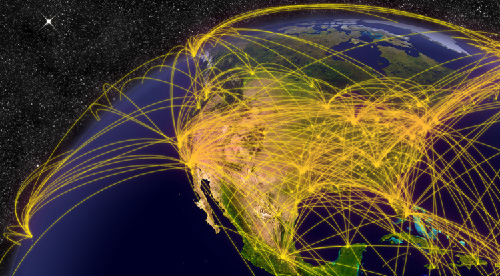
Jet contrails affect surface temperaturesBy A'NDREA ELYSE MESSER August 09, 2015
"Research done regarding September 2001, during the three days (following 9-11) when no commercial jets were in the sky, suggested that contrails had an effect," said Andrew M. Carleton, professor of geography. "But that was only three days. We needed to look longer, while jets were in the air, to determine the real impact of contrails on temperature and in terms of climate."
According to Woods Hole Oceanographic, there are approximately 30,000 commercial flights per day in the U.S. If the total round–trip flying time changed by an average of one minute, the amount of time commercial jets would spend in the air would change by approximately 300,000 hours per year. This translates to approximately 1 billion gallons of jet fuel, which is approximately $3 billion in fuel cost, and 10 billion kilograms of CO2 emitted, per year.
For contrails to form, the atmosphere at the level the jet is flying must be cold enough that the moisture from the jet exhaust freezes into ice crystals. There also must be enough moisture in the air that the clouds that form remain in the sky for at least a few hours as persisting contrails. Bernhardt and Carleton looked at temperature observations made at weather station sites in two areas of the U.S., one in the South in January and the other in the Midwest in April. They paired daily temperature data at each contrail site with a non-contrail site that broadly matched in land use-land cover, soil moisture and air mass conditions. The contrail data, derived from satellite imagery, were of persisting contrail outbreaks. The researchers reported their results in a recent issue of the International Journal of Climatology. They found that contrails depress the difference between daytime and nighttime temperatures, typically decreasing the maximum temperature and raising the minimum temperature. In this respect, the contrail clouds mimic the effect of ordinary clouds. The researchers report that the "diurnal temperature range was statistically significantly reduced at outbreak stations versus non-outbreak stations." In the South, this amounted to about a 6 degree Fahrenheit reduction in daily temperature range, while in the Midwest, there was about a 5 degree Fahrenheit reduction. Temperatures the days before and after the outbreaks did not show this effect, indicating that the lower temperatures were due to the contrail outbreaks. "Weather forecasting of daytime highs and lows do not include contrails," said Carleton. "If they were included in areas of contrail outbreaks, they would improve the temperature forecasts." The National Science Foundation supported this work.
Edited by Mary Kauffman, SitNews
Source of News:
|
||
